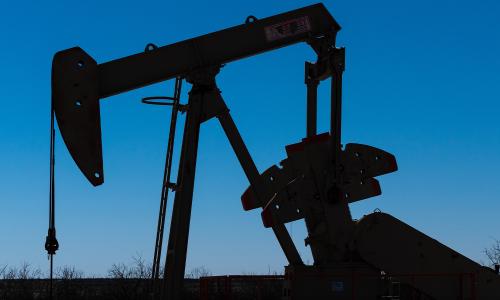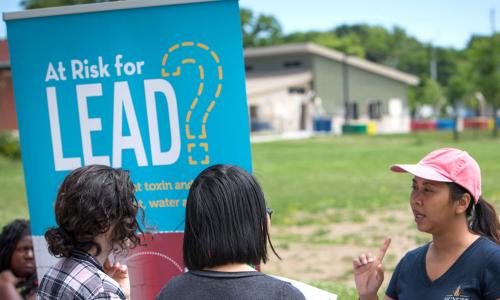Table of Contents
Hydraulic fracturing, or “fracking,” has been expanding dramatically in recent years, outpacing scientific knowledge and regulatory oversight. The rapid growth of fracking has brought concern and controversy over the technology's impacts, and affected communities often face a frustrating shortage of reliable information. It’s critical for scientists and citizens to work together to ensure that public discussions about fracking are informed by the best available evidence—and for policy makers to ensure that evidence drives their decisions.
What is fracking?
Fracking is a technique used to extract oil or gas from underground shale formations. A mixture of water, sand and chemicals is injected at high pressure into the rock, causing it to fracture (crack). This allows oil and gas contained in the rock to be recovered, often from sources that were previously inaccessible or uneconomical to explore. While industry often uses the word “fracking” to refer only to the specific fracturing step, the word is also commonly used to encompass the entire process of unconventional oil and gas development, including drilling, injection, production, and waste disposal.
Fracking is not a new technique, but recent technological advances, such as horizontal drilling, have spurred a rapid expansion of fracking in the United States. The U.S. Department of Energy projects that by 2040, nearly half of U.S. natural gas production and more than half of oil production in the lower 48 states will come from sites that employ fracking.
Weighing fracking pros and cons
Both the risks and the benefits of fracking are controversial, and communities need the help of science to sift through the conflicting narratives and focus on the evidence.
On the plus side, fracking proponents point to benefits such as lower energy prices, reduced global warming emissions compared to coal, and a stronger economy. Critics point out that natural gas, while preferable to coal, is not a climate panacea—and that local economic benefits of fracking may be short-lived, following a boom and bust cycle that disrupts the character and strains the resources of the host community.
Opponents point to public health concerns and environmental harms such as water contamination, air pollution, and increased earthquake risk near fracking sites; fracking advocates counter that all energy technologies have some environmental impact, and that there is not enough evidence to justify fracking restrictions.
In July 2013, through a Lewis M. Branscomb Forum, Science, Democracy, and Community Decisions on Fracking, we convened leading scientists, policymakers, journalists, and community advocates to consider what is known (and unknown) about fracking, and the implications for public discussion, policy and governance.
Fracking facts: an information gap
Our understanding of fracking has not always kept pace with the technology’s rapid growth—and industry has done little to bridge that gap. Our 2013 report, Toward an Evidence-based Fracking Debate, surveys our knowledge of fracking impacts and points out barriers to more complete information.
The exact composition of fracking chemicals, for instance, may be a mystery. In many places companies are not legally required to disclose what’s in their fracking fluid—and companies can often evade requirements by claiming specific chemicals as protected trade secrets.
Information on environmental impacts of fracking operations is often inadequate. Companies may prevent researchers from monitoring air or water quality at fracking sites—and even where such data is available, a shortage of baseline studies (which measure conditions before drilling begins) may make it hard to determine exactly what the impact of fracking has been.
Lawsuits against companies for harm caused by fracking operations can further clog the flow of information, since case settlements typically include nondisclosure agreements that prevent scientific data used in the case from being made public.
Fracking policy: a regulatory patchwork
What has government done to ensure that fracking does not damage human health or the environment? The answer depends on where you live.
While a number of federal environmental laws could potentially be used to regulate fracking, those laws often include loopholes that exempt the oil and gas industry from their provisions. The National Environmental Policy Act (NEPA), the Clean Water and Clean Air Acts, the Safe Drinking Water Act, and the Emergency Planning and Community Right-to-Know Act are some of the federal safeguards that include such exemptions.
As a result, regulation is mostly left up to the states, and state laws regulating fracking vary widely. In some states, for example, disclosure of fracking chemicals is entirely voluntary; in others it is required, but only after wells are drilled, and the requirement usually includes a trade secret exemption. As of 2013, only eight states had passed laws requiring baseline water quality testing at fracking sites, and just two required ongoing water quality monitoring.
These policy gaps can be mutually reinforcing. In Wyoming, for example, because there is no law requiring baseline water testing, people who live near fracking sites must do their own testing—but with a limited chemical disclosure law, it is difficult to know exactly which chemicals to test for.
Our 2015 report, Managing the Risks of Unconventional Oil and Gas Development, reviews the range of tools that local officials can use, depending on state laws and other factors, to manage the impact of fracking operations in their communities.
Fracking decisions: what communities and scientists can do
If you live in a community facing decisions about fracking, there are many ways you can make a difference, elevate the discussion, and advance science-based policy. Our toolkit, Science, Democracy, and Fracking: A Guide for Community Residents and Policy Makers Facing Decisions over Hydraulic Fracturing, offers a wealth of ideas for effective ways to get involved. Some key suggestions from the toolkit:
- Ask critical questions about the effect of fracking operations on public health, the environment, the local economy, and quality of life.
- Look for reliable information sources to help you answer these questions.
- Identify key stakeholders in your community who are likely to influence policy.
- Learn about the local, state and federal regulations that are relevant to fracking decisions.
- If you are a scientist or technical expert, make your expertise available to community groups, the media, and policymakers.




